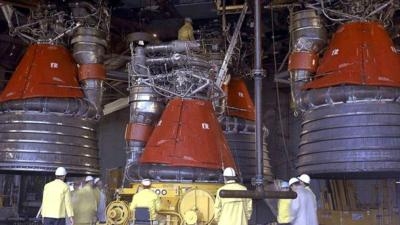Dynetics, Pratt & Whitney Rocketdyne Announce Exclusive Partnership To Compete For NASA SLS Booster Contract
As the space shuttles are shuffled off to be museum pieces, two companies are looking at older technology as in their bid to supply boosters for NASA's Space Launch System (SLS).

Dynetics and Pratt & Whitney Rocketdyne (PWR) made an announcement Wednesday at the National Space Symposium the formation of a long-term partnership to compete for the SLS Advanced Booster Engineering Demonstration and/or Risk Reduction (ABEDRR) procurement. Under this agreement, Dynetics and PWR are exclusive partners with respect to use of the proven Saturn V F-1 rocket engine technology.
“The SLS booster procurement requires a team that can balance affordability, innovation and experience throughout the life cycle – from development to production and operations,” said Steve Cook, Dynetics director of space technologies. “Dynetics and PWR have formed such a team, offering a wide-ranging set of risk reduction activities and demonstrations that enable a superior booster solution.”
Leading the SLS team as project manager is Kimberly Doering, a 28-year aerospace veteran with 13 years’ experience at NASA, including serving as deputy program manager of the Space Shuttle program. Doering most recently served as vice president of United Space Alliance's corporate business development and strategic planning, and vice president of Huntsville operations.
Ron Ramos, PWR’s vice president for Exploration and Missile Defense, explained the proven technology of the team. He said, “We offer a domestic booster design that takes advantage of the - more - flight-proven Apollo-Saturn F-1, still the most powerful U.S. liquid rocket engine ever flown. PWR is the only company to have returned a Saturn-era engine, the J-2X, to production. We bring unique lessons to the Advanced Booster cost and performance trades.”

The F-1 is ideally suited to the Advanced Booster, providing an ideal combination of high thrust-to-weight and reliability in a low-cost package, according to Cook and Ramos. “The high-cost non-recurring engineering typical of engine development was accomplished during the Apollo-Saturn program, and significant risks (e.g., turbopump design and combustion stability) were eliminated, so our team can focus on booster affordability rather than technical feasibility,” Cook said.
Dynetics has demonstrated an aggressive approach to low-cost innovation on space programs, such as Paul Allen’s Stratolaunch Systems and the FASTSAT microsatellite, and brings those lean system management methodologies to the proposed program. PWR, the original F-1 designer and producer, is the only U.S. company to develop and manufacture cryogenic engines over 200,000 lbf thrust. They bring successes from developing the RS-68 commercially, and their approach to engine manufacturing enables affordability at low production rates.
David King, Dynetics executive vice president, said, “Our integrated team offers an ideal mix of proven leadership; successful related experience; and innovative, low-cost, commercial management practices to enable an affordable and effective engineering demonstration and risk-reduction effort.” (Images provided by NASA)
 ANN's Daily Aero-Term (04.20.24): Light Gun
ANN's Daily Aero-Term (04.20.24): Light Gun Aero-News: Quote of the Day (04.20.24)
Aero-News: Quote of the Day (04.20.24) ANN's Daily Aero-Linx (04.21.24)
ANN's Daily Aero-Linx (04.21.24) Aero-News: Quote of the Day (04.21.24)
Aero-News: Quote of the Day (04.21.24) ANN's Daily Aero-Term (04.21.24): Aircraft Conflict
ANN's Daily Aero-Term (04.21.24): Aircraft Conflict




